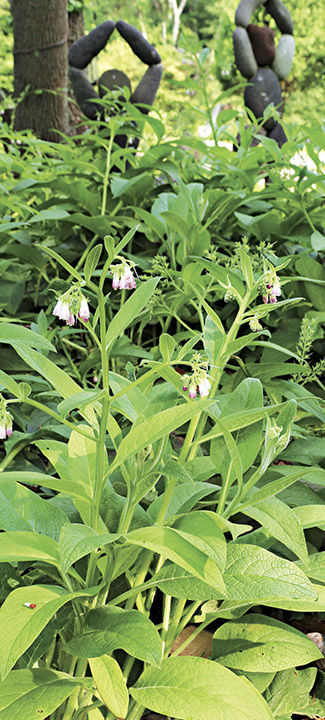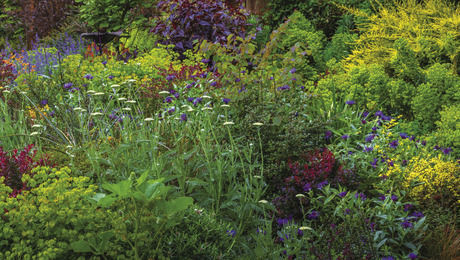
The first time I visited an established permaculture homestead, I felt an immediate connection to the way of life embodied in that special place. This well-designed living environment was also a highly functional ecosystem, with structures and plantings designed to meet peoples’ needs without negatively impacting the earth. Surrounded by rich biodiversity and simple, intelligent resource management systems, I thought, “Human beings are designed to live this way.”
The time I spent at the homestead inspired me to make changes to my own lifestyle and to pursue formal permaculture training. Now I make my living designing ecologically friendly landscapes and teaching others how to incorporate permaculture practices into their own homes and gardens.
Making a positive environmental impact is easier than you might think. Here are a few easy ways that you can put permaculture principles to work in your own home and garden.
What is Permaculture?
In a nutshell, permaculture is a framework used to design human habitats, based around a code of ethics that encourages ecological responsibility. Permaculture principles are modeled after nature’s brilliant designs, intended to help humans live within our ecological means, and create abundance from the natural resources available to us. We permaculture practitioners are challenged to shift our mind-sets from being consumers to producers, all while caring for and healing the ecosystems that support us.
1. Plant perennial edibles using the food forest model
Every year, a typical vegetable garden will require a large investment of labor and resources. But perennial crops can provide bountiful harvests each year with very little input from the gardener. In permaculture, there is a heavy emphasis on planting perennial food crops, which is a trick any one of us can use to grow more of the food we eat.
The natural layers found in a forest provide an excellent example that we can follow to make our perennial food plantings even more productive (shown in illustration above):
A – The tree canopy can provide nuts, fruit, and edible foliage.
B – The shrub layer provides berries, canes, and forage for animals.
C – The rhizosphere, or root layer, can give us roots, tubers, and edible fungi, as well as an opportunity to support biological diversity in the soil.
D – Vines can use trees and shrubs as trellises and can provide us with fruit and flowers.
E – Ground covers do two things: shade roots and act as a living mulch. They can also provide food for humans and other critters.
2. Catch and use rainwater


Wise water management is an especially effective way for gardeners to make a positive environmental impact. We can start by looking at ways to catch and store rainwater from rooftops and impermeable surfaces. A simple rain barrel can be added to just about any downspout.*
Once that water has been captured, we can make the most of it with wise management practices. Water is lazy—it follows gravity and the path of least resistance. So if we can locate rain catchment uphill from our gardens, water can be gravity-fed using low-tech irrigation techniques. If we can’t take advantage of an elevation drop, a simple pump can get the water where it needs to go.
During periods of heavy rain, storage tanks may fill up, so it’s wise to have a plan for managing overflow. Excess storm water can be diverted into bioretention areas such as rain gardens or infiltration swales.
*Roof-water collection is sometimes regulated by law. Check with your state or local authorities to find out the rules where you live.
3. Enlist animal allies

Healthy ecosystems have a diverse mix of plants and animals; their interactions create beneficial symbiotic relationships.
By creating habitat for wildlife, gardeners can help support a more balanced ecosystem. We can attract pollinators by planting the species that they use for food and shelter. We can find ways to encourage the predators that eat garden pests, such as birds and bats.
You may also wish to consider adding domesticated animals to your permaculture paradise. They can provide manure, food, and services like pest and weed control. Chickens are good starter animals and make fun garden helpers. If we are designing for birds, why not include the ones that can provide breakfast?
4. Take stock of your resources

One of the first steps in permaculture design is careful analysis of a site’s resources and inputs. In other words, think about what you have to work with and what you are bringing in from the outside. Permaculture practices tend to focus on making the most of what is naturally available. How much natural water and sunlight do you have to work with? If plants and animals provide products or ecosystem services, can you find ways to support and nourish them so that they can do their jobs even more efficiently? What do you bring into your garden? If you import fertilizers and mulches, perhaps there is a way to get those resources without being dependent on an outside source.

5. Plant soil builders
Plants, particularly nature’s hardworking pioneer species, have the ability to do many jobs in the landscape. Gardeners can learn how to reap the benefits plants provide: nitrogen fixing, producing biomass, and loosening soil with the power of taproots. Dynamic accumulators mine nutrients and minerals from deep in the soil; these nutrients are stored in the plants’ tissues and can then be used in a variety of ways.
For example, comfrey (Symphytum officinale, USDA Hardiness Zones 3–9) puts down deep roots and pulls nutrients from the soil. It produces a large volume of biomass, which is useful for mulch or composting. Its leaves can block weeds and shade the roots of nearby plants, and its flowers provide food for beneficial insects. The medicinal qualities of comfrey have also been recognized for many centuries.
6. Share your garden’s abundance

Permaculture goes beyond the garden in many ways. One of the core ethics of permaculture is a commitment to caring for other people and building community connections.
This is an ethic that comes naturally to gardeners. When our fruit trees and veggie gardens produce more than we can use, we share the abundance. We share our extra time as mentors and volunteers. We give back to people and the earth in a positive, regenerative way.
Put a little permaculture into your garden. You’ll find that a few small changes can make a world of difference.
A Swale is a Great Way to Catch Water
An infiltration swale is a simple concept: Soil is gently mounded along a contour so that storm water sheeting across the ground is slowed down, collected, and gradually absorbed into the soil. This technique prevents runoff and has the added benefit of irrigating plantings on the berm and at the edge of the swale.
Check with your local or state storm water management authority to learn whether this strategy is appropriate where you live.
Jessi Bloom is the owner and lead designer at N.W. Bloom, a design firm specializing in organic and sustainable landscapes, and coauthor of Practical Permaculture for Home Landscapes, Your Community, and the Whole Earth.
Photos: taken from Practical Permaculture for Home Landscapes, Your Community, and the Whole Earth © Copyright 2015 by Jessi Bloom and Dave Boehnlein, illustrations by Paul Kearsley. Published by Timber Press, Portland, OR. Used by permission of the publisher. All rights reserved. Additional Photos Carol Collins; Scott Phillips






















Comments
Interesting!
Log in or create an account to post a comment.
Sign up Log in